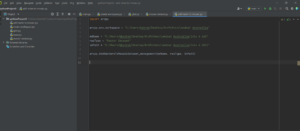Python Scripting for ArcGIS Pro
The book is helpful to start to get an understanding of Python, but it is difficult to interpret sometimes as it is prone to using jargon. It does define the jargon, or scripting terms, and explain how the terms relate to each other, but it does get confusing sometimes if you are unfamiliar with a lot of these concepts. The weakest part of the book is that it reads like a walkthrough, but there is no actual data package that comes with it so you are not able to perform all of the scripts it explains. Although the book works as a learning tool, I believe it works better as a reference guide.
Individual Project: ERSI Learning Courses
Even though I was not able to make as much progress as I wanted with the ESRI learning course, I do think the courses make it easier to learn Python much more than the book as you are able to actively learn through working with datasets and writing scripts. Additionally, you are immediately able to see the results of your scripts which makes you feel much more accomplished. There are many learning courses that you should be able to access and many of them are introductory level courses. The directions for the learning courses that I worked through were pretty thorough, so the biggest learning curve comes from navigating PyCharm than writing the code itself.
The work that was completed was certainly worthwhile; however, I hit an error that caused more errors and delays which prohibited me from completing the second learning course I was on. The main error occurred after I added a python interpreter to PyCharm as instructed in the “Python Scripting for Geoprocessing” course. After the interpreter was added and I ran the completed code and an error code appeared in the console. It reads as follows: C:\Program Files\ArcGIS\Pro\bin\Python\envs\arcgispro-py3\lib\site-packages\numpy\__init__.py:143: UserWarning: mkl-service package failed to import, therefore Intel(R) MKL initialization ensuring its correct out-of-the-box operation under condition when Gnu OpenMP had already been loaded by Python process is not assured. Please install mkl-service package, see http://github.com/IntelPython/mkl-service from . import _distributor_init
I tried following the link but that lead to many dead ends. I also discovered that PyCharm stopped recognizing arcpy as a module around this time. This may have been from the version of Python I was using but after I tried changing it, the error still appeared.
I then tried following the file path listed in the error code: “C:\Program Files\ArcGIS\Pro\bin\Python\envs\arcgispro-py3\lib\site-packages\numby\__init__.py:143.” I could not find “__init__.py:143” in the numpy folder.
I went to the settings and clicked on the Python interpreter and saw that the packages are actually listed. I found the mkl-service package in the list so I wasn’t sure why it wasn’t working. I clicked the plus sign to add a package, searched for the mkl-service package, and clicked install. However, an error occurred claiming that I did not “have the write permissions to the target environment.
I worked with someone from OWU tech support and we discovered that I did have administration access and we tried a couple of alternative methods but determined that the error may stem from a problem with the actual PyCharm software itself. Hopefully, you don’t encounter any of these errors as they are a pain to deal with.
Overall, I am proud of the work I was able to complete. I definitely think the learning courses are worth exploring and should maybe be the primary focus of the course, rather than reading the book. I think I retained knowledge better from the courses than from the book itself, but this could be a reflection of my learning style. The book is still a worthy investment. Taking down notes will slow your progress, but they definitely will help you retain more information.




